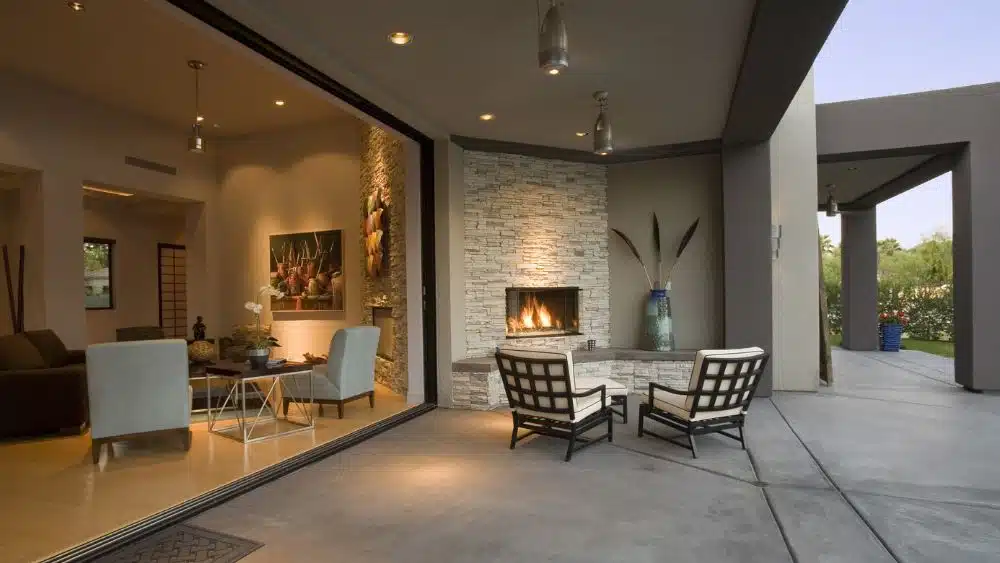Why are fireplaces so charming? Besides adding monetary value to a home, fireplaces evoke coziness and relaxation, and are often a focal point in a room. When considering a fireplace for a new build or remodel, your options are gas, wood-burning, and electric. You’ll have to evaluate your current home structure, consider building codes in your area, and think about your budget (for purchase and installation) when trying to decide in which fireplace to invest. We’ll break down the options, least to most expensive, below.
Electric Fireplace

At first thought, you might be thinking of the tacky 2010 versions with colorful blue and red flames. Don’t worry: Technology has come a long way since then. With an electric fireplace, the ‘flame’ is often created by LED lights. Heat is produced independently, so you can choose to run the flames without heat during warm weather. The flames aren’t real so there’s no need for venting, which brings the cost down. Plus, cleanup is simple as there’s no soot or smoke produced. For setup, all you need to do is plug in the fireplace to a wall outlet, making sure it is on a dedicated circuit or fuse. Electric fireplaces can be inserts, freestanding, or wall-mounted.
Insert
Price: $300 to $1,500
If you already have a traditional fireplace cavity, you can easily pop in an inset electric fireplace. They’re easy enough to shift around, so you always have the option of moving it if you don’t like the placement.
Freestanding
Price: $300 to $1,000
No chimney or wall cavity? No problem. A free-standing electric fireplace is your best bet. These models tend to have a more traditional look and, since it’s electric, you can easily mount a TV above. The downside is they take up more square footage when compared to an inset or wall-mounted option.
Wall-Mount
Price: $300 to $2,000
Wall-mounts are easy to install, and can be hung or built-in. If it’s built-in, the unit will usually still jut out a few inches to allow for cooling.
Gas Fireplace

Gas fireplaces can be broken down into three types: inserts, log sets, or built-ins. Log sets are more decorative while inserts and built-ins reliably produce more heat. A key consideration for all three to keep in mind is if the firebox, which is the part of the fireplace where you light and burn fires, is vented or unvented.
Insert
Price: $2,000 to $4,000
Inserts are basically a self-contained unit that uses natural gas or propane. They can be fitted to convert an existing wood-burning fireplace into a more convenient and efficient way to heat your home. All you have to do is flick a switch for the fire to come on!
Built-In
Price: $2,000 to $4,000 (including installation but not the mantel or surround)
Goodbye, ashes and firewood fetching. Built-ins are like inserts but don’t require an existing fireplace or chimney, and they’re easy to install: simply connect them to the natural gas line in your house. Additionally, you can fully control their temperature and flame height.
Log Set
Price: $400 to $1,000
A log set is a great cost-effective alternative to burning real wood. These logs are made of ceramic or glass, look like firewood, and use natural gas or propane to work. Although visually appealing, they do not emit as much heat when compared to an insert or built-in. Log sets come with updated features like remote controls or automatic ignitions. When comparing vented versus unvented logs, there is also a list of pros and cons. Vented log sets deliver beautiful flames like a real fire but lose heat and require more fuel. Ventless log sets are typically more expensive but have a greater payoff in terms of heat and fuel efficiency.
Wood-Burning Fireplace

Price: $8,000 to $12,000
Used for centuries, wood-burning fireplaces are what most people think of when they imagine sitting by the fireplace and listening to it crackle. While they are associated with labor, safety regulations, and health risks, it’s possible to have a warm hearth in a safe, sustainable way.
The initial cost of installation and masonry is higher than the other two types of fireplaces, but there is no reoccurring utility cost. However, you do have to factor in the price of firewood, especially if there isn’t readily available chopped wood near you. It is also critical to have a chimney or venting system with a wood-burning fireplace.
Rakini Bergundy was born in a little surf town called Houhai in China and loves writing. She’s passionate about dogs, home renovations, and politics.
 Best Modular Home Builders in Iowa
Best Modular Home Builders in Iowa